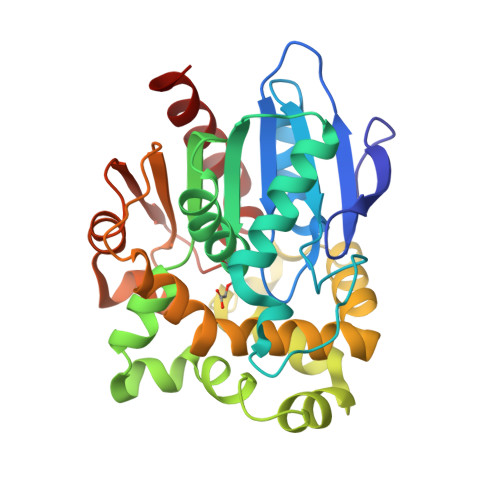Structural insights into hydrolytic defluorination of difluoroacetate by microbial fluoroacetate dehalogenases.
Khusnutdinova, A.N., Batyrova, K.A., Brown, G., Fedorchuk, T., Chai, Y.S., Skarina, T., Flick, R., Petit, A.P., Savchenko, A., Stogios, P., Yakunin, A.F.(2023) FEBS J 290: 4966-4983
- PubMed: 37437000
- DOI: https://doi.org/10.1111/febs.16903
- Primary Citation of Related Structures:
8SDC, 8SDD - PubMed Abstract:
Fluorine forms the strongest single bond to carbon with the highest bond dissociation energy among natural products. However, fluoroacetate dehalogenases (FADs) have been shown to hydrolyze this bond in fluoroacetate under mild reaction conditions. Furthermore, two recent studies demonstrated that the FAD RPA1163 from Rhodopseudomonas palustris can also accept bulkier substrates. In this study, we explored the substrate promiscuity of microbial FADs and their ability to defluorinate polyfluorinated organic acids. Enzymatic screening of eight purified dehalogenases with reported fluoroacetate defluorination activity revealed significant hydrolytic activity against difluoroacetate in three proteins. Product analysis using liquid chromatography-mass spectrometry identified glyoxylic acid as the final product of enzymatic DFA defluorination. The crystal structures of DAR3835 from Dechloromonas aromatica and NOS0089 from Nostoc sp. were determined in the apo-state along with the DAR3835 H274N glycolyl intermediate. Structure-based site-directed mutagenesis of DAR3835 demonstrated a key role for the catalytic triad and other active site residues in the defluorination of both fluoroacetate and difluoroacetate. Computational analysis of the dimer structures of DAR3835, NOS0089, and RPA1163 indicated the presence of one substrate access tunnel in each protomer. Moreover, protein-ligand docking simulations suggested similar catalytic mechanisms for the defluorination of both fluoroacetate and difluoroacetate, with difluoroacetate being defluorinated via two consecutive defluorination reactions producing glyoxylate as the final product. Thus, our findings provide molecular insights into substrate promiscuity and catalytic mechanism of FADs, which are promising biocatalysts for applications in synthetic chemistry and bioremediation of fluorochemicals.
Organizational Affiliation:
Department of Chemical Engineering and Applied Chemistry, University of Toronto, ON, Canada.















